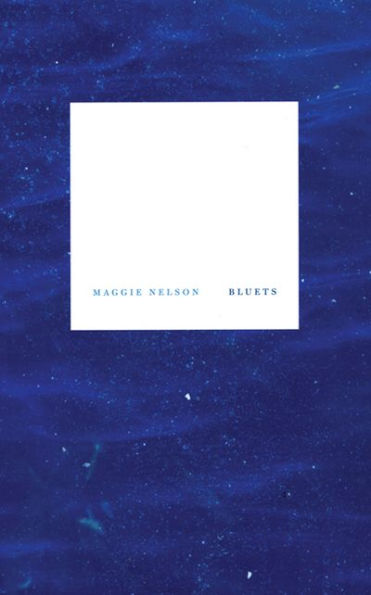"Nelson's expressive style springs from her subject as much as the content, in turn, inflects her vocabulary, tone and structure. Seeking such reciprocity—no less an ideal than, say, 'the spontaneous overflow of powerful feelings'—may radically redefine poetry, as it increasingly becomes the genre that is not one."—Albert Mobilio, Bookforum"An elegant, indispensable addition to the genre of the lyric essay."—Kathleen Rooney, Boston Review"Maggie Nelson continues to raise the bar higher in what a reader can expect from a book. Bluets is smart yet intimate, quiet yet provocative, and a welcome addition to the poetic non-fiction discourse."—Susie DeFord, BOMB"In the end Nelson breaks free of romance’s tyranny. She dreams someone sends her cornflowers, the American name for bluets. Shaggy, wild, and strong—they’re a revealing metaphor for the author."—Jeffrey Cyphers Wright, The Brooklyn Rail"In 240 entries, Nelson relates a history of blue from philosophical, zoological and literary perspectives, all the while weaving in bits of memoir and emotional rumination. Through this collage, she broadens the definition of blue from a merely visual phenomenon to a vehicle for the divine."—Catherine Lacey, Time Out New York "It’s an impossible book to describe without simply handing it to you; it is, hackneyed as it is to say, a book to be experienced. I can only report that I am reading it again and again, that the resonances between the (seemingly) disparate propositions are startling and emotional, that I suspect your reaction will be different and also quite wonderful."—Peter Rock, The Rumpus"Brash, feverish, intractable, exploratory, and terribly 'touchant' Nelson’s Bluets is, I am reminded for some reason (it’s in Marías) of Rimbaud’s line: 'Par délicatesse / J’ai perdu ma vie.'"—John Latta, Isola di Rifuti "Nelson doesn’t want to leave anything out, as suits a collector’s project. Thus, in the same way that she wanders among blue objects (shards of glass, bottles of ink, stones and tattoos and the nests of bowerbirds) and accidental theorists of color (Goethe and Newton and Duras and Novalis) and the color’s utility in human imagination (blue moods, blues music, the blue divine), she likewise wanders among the positions the orchestrator of these lists must adopt. This results in an admixture of candor, passion and detachment that makes for irresistible intimacy."—Ray McDaniel, The Constant Critic"The book is a philosophical and personal exploration of what the color blue has done to Nelson. Despite the exhaustion, Bluets wears its hybrid/fragmented dress well, showing its seams and much enthralled by its wanderlust, an aesthetic runway that constantly leads Nelson to find new ideas, images, and expressions."—Thomas Larson, TriQuarterly"Bluets reaches far beyond the constraints of its subject, resulting in a series of delicately associative numbered paragraphs investigating a broken romantic relationship, a friend’s chronic nerve pain, the writing process itself, and the deceptive elements of perception and color. The result not only defies easy categorization, but also leans toward Walter Benjamin’s famous declaration that all great works of literature either dissolve a genre or invent one."—Rob Schlegel, Jacket


